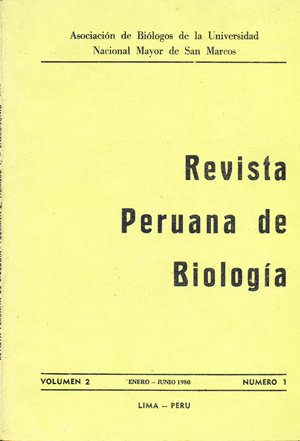La Maca (Lepidium peruvianum Chacón sp. nov.) y su Habitat
DOI:
https://doi.org/10.15381/rpb.v3i2.8305Palabras clave:
Lepidum, maca, fitoquímica, biodiversidadResumen
Este estudio presenta la descripción taxonómica de un ejemplar tipo de la MACA obtenido el 9 de septiembre de 1989 cerca de Huarancaca, ciudad de Cerro de Pasco, del Departamento de Pasco, como Lepidium peruvianum Chacon sp. nov., especie nueva para el género Lepidium (CRUCIFERA), las características que la distinguen de las especies afines especialmente de Lepidium meyenii Walp. y de Lepidium gelidium Wedd. están especificadas en este estudio. Igualmente presenta el estudio fitoquímico de la MACA realizado en 1960-1962, su hábitat y aclimatación a niveles de la costa. Esta especie cuyo nombre es MACA es oriunda de los Andes Centrales del Perú y se la conoce tanto por su valor alimenticio como farmacológico desde antes de la época del incanato. Crece en los Departamentos de Pasco y Junín en altitudes de 4100 y 4300 m sobre el nivel del mar. El clima en esta región es frío y seco durante el año caracterizándose el verano (enero, febrero y marzo) como lluvioso con un promedio de 250,8 mm y con una temperatura ambiental promedio de 4.8 °C. En invierno (junio, julio y agosto) las lluvias son escasas llegando a 34.4 mm y el promedio de la temperatura ambiental es alrededor de 3.5 °C. Los análisis químicos de la raíz realizados en 1960 y 1961 han demostrado la presencia de glúcidos y cuatro tipos de alcaloides, presentadas en cromatografía de papel Whatman. Estos alcaloides que he denominado "Extracto alcaloideo/marzo 1961", son los principios activos que intervienen en la frecuencia de procreación y dela clara y marcada estimulación de la maduración de los folículos de Graaf realizados en experimentos con ratas y en los machos, un aumento en la cantidad de espermatozoides en los tubos seminíferos y aumento de mitosis y espermatogonia. Estos ensayos los he realizado en el Instituto de Patología de la Facultad de Medicina Humana [de la UNMSM] durante los años 1961 y 1962. Las observaciones histológicas e histoquímicas realizado en 1989 y 1990 en el ejemplar tipo han demostrado que esta especie presenta alcaloides y glúcidos, principios químicos que caracterizaron a los ejemplares de San Juan de Jarpa y Carhuamayo del Departamento de Junín en 1960-1962. Igualmente tiene elevada concentración de Ca, P y Fe, siendo éste último junto con los alcaloides el potencial medicinal de la planta. Se incluyen 10 cuadros, 12 diagramas, 94 fotos y 4 protocolos de autopsia.
Descargas
Descargas
Publicado
Número
Sección
Licencia
Derechos de autor 1990 Gloria Chacon

Esta obra está bajo una licencia internacional Creative Commons Atribución-NoComercial-CompartirIgual 4.0.
LOS AUTORES RETIENEN SUS DERECHOS:
a. Los autores retienen sus derechos de marca y patente, y también sobre cualquier proceso o procedimiento descrito en el artículo.
b. Los autores retienen el derecho de compartir, copiar, distribuir, ejecutar y comunicar públicamente el artículo publicado en la Revista Peruana de Biología (por ejemplo, colocarlo en un repositorio institucional o publicarlo en un libro), con un reconocimiento de su publicación inicial en la Revista Peruana de Biología.
c. Los autores retienen el derecho a hacer una posterior publicación de su trabajo, de utilizar el artículo o cualquier parte de aquel (por ejemplo: una compilación de sus trabajos, notas para conferencias, tesis, o para un libro), siempre que indiquen su publicación inicial en la Revista Peruana de Biología (autores del trabajo, revista, volumen, número y fecha).






